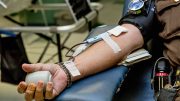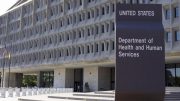By: Eric Brus*—
The U.S. Center for Disease Control and Prevention (CDC) reports that annual HIV diagnoses fell 19% in the U.S. from 2005 to 2014, primarily as a result of large and continuing declines in new diagnoses among several population groups, including heterosexuals, people who inject drugs, and African Americans―with the greatest declines occurring among Black women. In contrast, the trends among gay and bisexual men were mixed, varying widely by race and ethnicity. Eugene McCray, director of the U.S. Center for Disease Control and Prevention (CDC) Division of HIV/AIDS Prevention presented these data at the opening of the 2015 National HIV Prevention Conference in Atlanta, Georgia. [pullquote]In contrast, the trends among gay and bisexual men were mixed, varying widely by race and ethnicity.[/pullquote]
McCray reported that, among White gay and bisexual men, new diagnoses fell steadily, declining a total of 18% during the past decade. In sharp contrast, new HIV diagnoses among Latino gay and bisexual men continued to rise and were up 24% since 2005. Similarly, new diagnoses among Black gay and bisexual men also rose 22% since 2005, but that increase leveled off since 2010. A similar pattern was seen among the subgroup of young Black gay and bisexual men ages 13 through 24. In that age group, annual HIV diagnoses rose a total of 87% between 2005 and 2014, but the increase was concentrated in the first half of that period. The trend has largely leveled off, with a small decline of two percent occurring between 2010 and 2014.
“Although we are encouraged by the recent slowing of the epidemic among black gay and bisexual men―especially young men―they continue to face a disproportionately high HIV burden and we must address it,” noted Jonathan Mermin, director of CDC’s National Center for HIV/AIDS, Viral Hepatitis, STD, and TB Prevention. “Much more must be done to reduce new infections and to reverse the increases among Latino men. There is hope that the National HIV/AIDS Strategy and other efforts are beginning to pay off, but we can’t rest until we see equal gains for all races and risk groups.”
In their analysis of trends in HIV diagnoses, CDC researchers focused on two time periods, 2005 through 2014 and 2010 through 2014, to provide both a decade-long perspective as well as a more recent view of trends. Their key findings, including data on the total number of diagnoses in different demographic groups and transmission categories, are summarized below: [pullquote]In sharp contrast, new HIV diagnoses among Latino gay and bisexual men continued to rise and were up 24% since 2005. Similarly, new diagnoses among Black gay and bisexual men also rose 22% since 2005, but that increase leveled off since 2010.[/pullquote]
- Between 2005 and 2014, the annual number of HIV diagnoses in the U.S. declined 19% (from 48,795 to 39,718 per year) – thanks largely to substantial decreases among heterosexuals (down 35%) and people who inject drugs (down 63%).
- HIV diagnoses among Black women fell 42% (from 8,020 to 4,623) between 2005 and 2014. A 25% decline occurred between 2010 and 2014.
- Considered as a whole, the annual HIV diagnoses among gay and bisexual men rose about 6% over the decade (from 25,155 to 26,612). However, as noted above, there were large racial/ethnic disparities in the trends in HIV diagnoses among gay and bisexual men.
- In particular, annual HIV diagnoses fell steadily among White gay and bisexual men—both over the decade (decreasing 18% from 9,966 to 8,207) and in the most recent five-year period (decreasing 6% from 8,766 to 8,207).
- In contrast, new HIV diagnoses among Black gay and bisexual men increased by 22% (from 8,235 to 10,080) during the decade but stabilized in the most recent period (10,013 in 2010 to 10,080 in 2014).
- While Black gay and bisexual men ages 13 through 24 experienced a steep increase in diagnoses over the decade (87% from 2,094 to 3,923), diagnoses among young Black gay and bisexual men actually declined slightly (2%, from 3,994 to 3,923) in the period 2010 through 2014.
- Finally, diagnoses continued to increase among Latino gay and bisexual men—both over the decade (by 24% from 5,492 to 6,829) and in the most recent five-year period (by 13% from 6,060 to 6,829).
CDC analysts found that HIV testing remained stable or increased among the groups that experienced declines in new HIV diagnoses in recent years. As a result, they believe the decreases in diagnoses reflect a decline in new HIV infections. Similarly, because HIV testing remained stable among Latino gay and bisexual men during this period, the increases in HIV diagnoses suggest HIV infections are likely increasing in this group.
CDC Estimates That There Are Over 1.2 Million Candidates for PrEP in the U.S.
In recent years, a growing number of studies have shown that, when used properly, pre-exposure prophylaxis (PrEP), medication that interferes with HIV’s attempts to establish an infection and which, if taken daily, can dramatically reduce the risk of HIV infection. If PrEP were widely available and used among persons at greatest risk for HIV infection, it might substantially decrease the number of new HIV infections. CDC researchers recently analyzed data from national population-based surveys to estimate the percentages and numbers of persons with indications for PrEP in each of three transmission-risk populations: gay, bisexual, and other men who have sex with men (MSM); heterosexually active adults; and persons who inject drugs. Their findings are published in an article in the November 27 issue of the Morbidity and Mortality Weekly Report (MMWR).
The researchers looked at the prevalence of surveyed behaviors that were most closely related to those included in the U.S. Public Health Service (PHS) 2014 clinical practice guideline for PrEP. These behaviors included the number and characteristics of sex partners, patterns of sexual activity (such as condomless sex), recent diagnoses of sexually transmitted infections, and recent injection drug use.
Their analysis indicated that:
- About one-quarter of all sexually active, HIV-negative MSM―approximately 492,000 people―have indications for PrEP consistent with PHS’s 2014 PrEP guideline;
- About one-fifth of all HIV-negative persons who inject drugs―approximately 115,000 people―have indications for PrEP.
- About one in 200 HIV-negative, heterosexually active adults―approximately 624,000 people―have indications for PrEP.
Altogether, an estimated 1,232,000 adults in the United States have substantial risk for acquiring HIV infection. It is worth noting that, due to the limitations and uncertainties in the data, the actual number of persons who meet the PHS’s PrEP guidelines might actually be as low as 661,000 or as high as 1.8 million, according to CDC. “Efforts to increase knowledge of and access to PrEP should accompany efforts to increase early diagnosis and treatment of persons with HIV infection to achieve the prevention benefits of viral suppression,” the CDC researchers noted. “Reducing disparities in access to clinical care for the prevention and treatment of HIV infection can accelerate achieving the National HIV/AIDS Strategy 2020 goal for reducing the number of new HIV infections in the U.S.” [pullquote]“Reducing disparities in access to clinical care for the prevention and treatment of HIV infection can accelerate achieving the National HIV/AIDS Strategy 2020 goal for reducing the number of new HIV infections in the U.S.”[/pullquote]
Transgender Women and PrEP Brief from the National Center for Innovation in HIV Care
Research studies indicate that nearly one-fifth of all transgender women worldwide are living with HIV infection―an HIV prevalence rate about 50 times higher than that of the general adult population. Earlier this month, the National Center for Innovation in HIV Care published a new issue brief that looks at the potential of PrEP to reduce the risk of HIV infection among transgender women. The 24-page brief, Transgender Women and Pre-Exposure Prophylaxis: What We Know and What We Still Need to Know, includes:
- discussion of the research to date on the safety of PrEP use among transgender women;
- guidance for clinicians on prescribing PrEP to transgender women; and
- recommendations for more intensive research on HIV prevention technologies for transgender women.
“More research is needed to demonstrate that PrEP is effective for preventing HIV infection among transgender women engaging in anal intercourse with men,” according to the brief. “Research is also needed to better understand the interaction of PrEP and feminizing hormones, and any potential impact on the ability of PrEP to build up in sufficient concentrations in rectal tissue. In the meantime, PrEP is a prevention option that transgender women should consider with their medical providers.”
World AIDS Day 2015 Perspectives: Ten Things Policymakers Can Do to End HIV
In a World AIDS Day blog post, Murray Penner, executive director of the National Alliance of State and Territorial AIDS Directors, presented a list of 10 things policymakers can do now to end HIV. Here is his list, in abbreviated form:
- Work and think in completely new ways: collaborate, leverage resources, and advocate with all stakeholders.
- Ensure that the Ryan White HIV/AIDS Program remains strong and fills gaps in services.
- Ensure that public health, payers, primary health care, and other systems interact seamlessly with each other to improve access to a range of public health prevention and care services.
- Break down data siloes and improve collection, timeliness, and accuracy in order to make decisions that improve outcomes and keep people engaged in the health system.
- Revolutionize public health services for the transgender community and gay men to reach people where they are.
- Provide comprehensive drug user health and harm reduction programs to address the needs of people who inject drugs and, in particular, the epidemic of opioid abuse.
- Meaningfully address social determinants of health and reduce health inequities and stigma, including the implementation of programs to undo racism and homophobia.
- Increase research and development of long-acting treatments, cures, and vaccines, as well as new treatments to address drug-resistant strains of STDs and other diseases.
- Scale up the use of PrEP and make it available for all who could benefit.
- Provide routine HIV, hepatitis C and STD testing to everyone without barriers, and provide treatment to all persons living with HIV and hepatitis C as soon as possible.
*Eric Brus is the Director of Health Information at AIDS Action Committee. This report is produced by the Health Library of the AIDS Action Committee in collaboration with the New England AIDS Education and Training Center Minority AIDS Initiative Project. The full version is available online.








